Stardust – The First Comet Coma Sample Return Mission!
Cosmic Dust, Comets Coma
The Stardust mission to collect dust from the coma of comet Wild 2 during its close encounter (along with cosmic dust), and return it to Earth was the first of its kind! Following the successful sample return, the Stardust spacecraft received a mission extension to intercept, and image, comet Tempel 1 which had previously been visited by Deep Impact.
The Stardust Mission Fast Summary Facts!
- Type: Flyby, Sample Return
- Destination: Comet Wild 2
- Status: Decommissioned
- Launch Location: Cape Canaveral, Florida
- Launch Date: February 7th 1999
- Flyby Of Wild 2: January 2nd 2004
- Sample Return Date: January 15th 2006
- Mission Duration: 6 Years, 11 Months
Learn Interesting Fun Facts About The Stardust Mission!
- There were three primary objectives of this NASA Discovery-class mission; collect and return comet coma particles, interstellar dust and image the nucleus of the comet Wild 2.
- The comet Wild 2 (81P/Wild) is unusual as until a recent encounter with Jupiter in 1974, it was a long-period comet but is now a short-period one.
- After 3 ½ years of travel, the Stardust spacecraft made a flyby of 5538 Annefrank, imaging it while practising its flyby for comet Wild 2!
- The Stardust flyby of comet Wild 2 passed through the comet's coma only 236 km from the nucleus, collecting particles as it did by using its ‘Aerogel’ and capturing close up images!
- Stardust then returned to Earth in early 2006, where the probe jettisoned the capsule containing particles from the comet and interstellar dust.
- The Stardust capsule re-entered the Earth's atmosphere at a tremendous velocity of 12.9 km/s - the fastest re-entry speed by a man-made object ever!
- The capsule also endured extreme forces as it passed through the increasingly thick atmosphere, decelerating from a velocity of Mach 36 to subsonic speeds in less than 2 minutes reaching a peak deceleration of 34 g! However, it would land safely on-target in the Utah desert.
- In 2009, following the successful completion of the Stardust mission, the main Stardust spacecraft was commanded by NASA to follow up from the previous Deep Impact mission by performing a flyby of comet Tempel 1 to image and collect data.
- The cost of the mission was approximately USD $220 million, including the Delta II rocket launch. Amazingly, this is considered a relatively ‘low cost’ exploration mission!






Stardust Checks
Stardust Launch
Vehicle Diagram
Stardust Trajectory
Coma Chaser
Stardust Return Capsule



